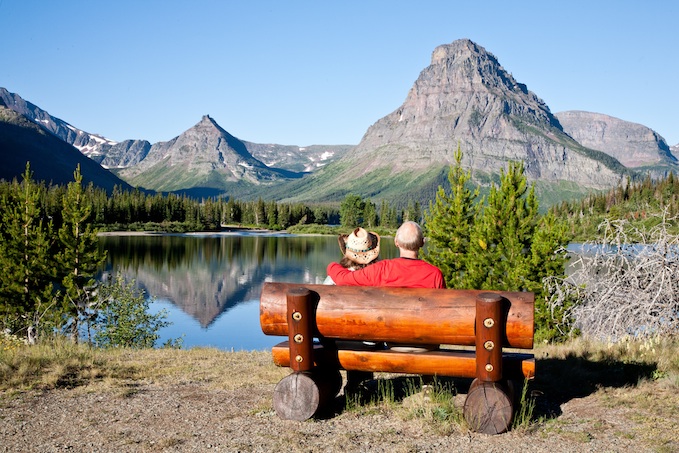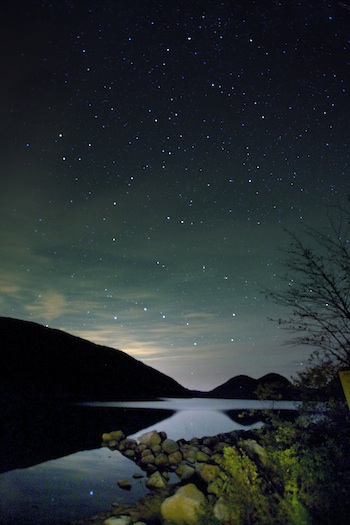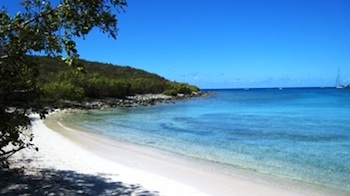
Dave and Connie Hopkins enjoy the view from their “backyard,” Pray Lake in Glacier National Park. Photo courtesy of the Hopkins.
If you’re enticed by retirement near a national park, your options swell to 401. But how do you decide which park is perfect for you?
If you like geysers and bison, a home near Yellowstone in northwest Wyoming is for you. Like to hike? Then Great Smoky Mountains, with some 900 miles of trails crisscrossing the park that straddles North Carolina and Tennessee, should suit you. Southern hospitality and a long strip of asphalt to cruise through the bucolic countryside? Locations abound along the 444-mile-long Natchez Trace Parkway. A mix of mountains and coastline? Look at the neighborhood surrounding Acadia National Park.
But along with considering your preferred park, you must work through a host of other issues, from real estate and taxes to Internet service and cabin fever.
Dave and Connie Hopkins, for example, were torn between Glacier National Park in northern Montana and Yellowstone in northwest Wyoming. They always knew they would retire in the Rockies somewhere, but filtering out the possibilities required homework. A lot of homework.
Finding that perfect retirement home is one thing, says Connie, but when you’re living on a fixed income, rising or steep taxes can make that dream home unaffordable in the long run.
“We both love the mountains and knew that one day we wanted to retire in a place where we could wake up each morning and look out the windows to magnificent views,” she says. “We wanted a small amount of property (under 5 acres) and lots of trees. Our two favorite national parks are Yellowstone and Glacier, so we wanted to move to an area where we could make the drive in a reasonable amount of time.”
What else factored into their decision? They wanted a setting less crowded than what they knew in pre-retirement Texas, access to quality medical care, of course, a nearby population center for when they needed a dose of society, and reasonable taxes.
Once they laid out their priorities, the couple did their homework. Five years before they settled on their dream home, they began searching the areas under consideration for property to build on as well as pre-existing homes for sale. “After investing a lot of time and energy looking at literally hundreds and hundreds of listings, we realized our dream of retiring out West wasn’t a whim; if it were, I would’ve stopped looking after the first year!” says Connie.

Starry skies over Acadia National Park, a perfect bedtime setting. Marco Crupi photo.
Locating a realtor, one who understands your needs and wants, is a logical step in the process. The couple located one who both understood their desires and budget and was well-familiar with the area where they wanted to retire.
“He was aware of potential property listings in the area that I was not, 1,800 miles away! He’s the hands-on-guy, doing the leg work that I was unable to do,” Connie explains. “A good realtor is an asset, helping you to make good decisions and ‘live the dream.’”
If you’re considering park backdrops for retirement, the Hopkinses urge you to list the factors important to you.
“What are the things that you will not be able to live without? You make absolutely, positively certain that ‘Gateway Town USA’ has those things that you cannot live without. Minimize the risk of unpleasant surprises,” says Connie. “When you use good judgment and make wise decisions when it comes to all the major issues, you’ll find it much easier to deal with the unexpected minor issues that will inevitably surface over the course of time.
“There’s the old adage, ‘luck favors the prepared.’ Do not leave things to chance; take all the time that is needed to complete your homework and be prepared.”
A pleasant surprise for the couple was today’s mortgage climate. Their realtor found a home in foreclosure, held by a bank that wanted to “get it off their books.” They wound up paying roughly half what the house was appraised for in 2007, before the market crashed.
After all that hard work, the Hopkins’ decision was easy: Columbia Falls, Montana, the proverbial stone’s throw away from Glacier National Park’s west entrance.
Either way you look at ‘retirement’–after a long career, or just a long year–national park gateway communities are an attractive, rejuvenating, secret setting. These are places where “a there” is definitely “there”–the park–and there’s an enviable lifestyle to go with it. Even a short-term vacationer can sink into a real experience–in the park and its gateway–if you take a hint from the locals.
With so many units of the National Park System, we don’t have the space to tackle every possible gateway to retirement. But we offer the following considerations you should take to heart before closing on your “dream” property:
• If you’re moving from a big city to a tiny town, brace yourself for culture shock.
Virgin Islands National Park can place a tropical paradise in your backyard. Kurt Repanshek photo.
There might not be a Starbucks in the area, and high-speed Internet service could come at a premium, if it’s available at all.
• Some folks set the stage for retirement by buying their retirement home before leaving work, which is the approach the Connie and Dave took. If you live close enough to your gateway goal, you can be paying for your house while the bucks are still flowing, getting settled in the local culture (making friends, building a future), and even realizing some vacation rental income.
• Moving across the country could move you into an entirely different climate, such as going from moist, humid West Coast to the dry and high Rocky Mountains. That kind of thing takes getting used to in terms of the thinner air and lack of humidity.
• If you’re hoping to work in semi-retirement, you might either be hard-pressed to find a job that suits you, or one that comes close to your previous income.
Part of your homework should include searching out magazines, such as Money and Forbes, that annually list best retirement locations. Those locations might not be near national parks, but the factors those publications raise can help you with your homework.


 Support Essential Coverage of Essential Places
Support Essential Coverage of Essential Places







Comments
I was born in Columbia Falls and lived there until I was 9. I totally agree with you about doing your homework and being prepared - be it finding a place for retirement or just deciding where to go on the next photography trip. Columbia Falls is close to both the park and the much larger town of Kalispell. I take it Kalispell would have been a more expensive choice for you?
Some very good advice. Retiring near a park can have lots of advantages for many people, but it is very true that a place that seems very appealing during a vacation may not turn out to be as attractive on a year-round basis. I suspect many of our friends who "loved" Glacier when they visited us there in July would have felt differently about it after a couple of weeks in January :-)
I already live an hour and a half from Paradise (on Mt. Rainier). And I'm not budging [g].
Actually Dave and I considered the Kalispell/Whitefish/ Columbia Falls triangle, even looking at a house in Somers last July. Our retirement home is on the North Fork Road, our little spot of heaven. Getting the home as a foreclosure was the icing on the cake. We ended up with so much more bang for our buck, having enough left in our budget for some upgrades and remodeling. We are headed up to the house in *10 weeks, after my beloved finishes a round of radiation treatment. No better spot for us to relax and chill!
I know this is old posting but we find ourselves in similar situation .... how can I find a good real estate agent?